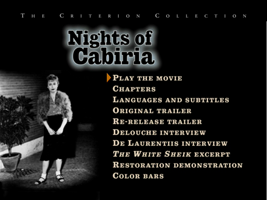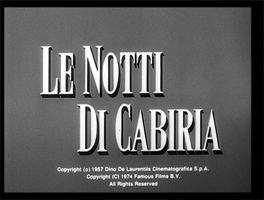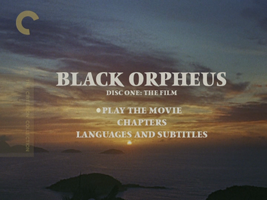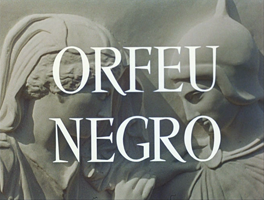directed by Federico Fellini
story and screenplay by Federico Fellini and Tonino Guerro
opera texts by Andrea Zanzotto

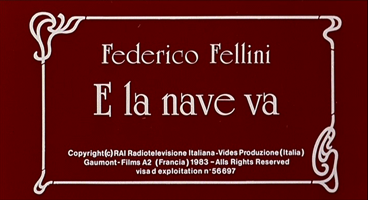
Criterion #50. And the Ship Sails On.
You know he’s a big deal when this is one of his minor films.
Fellini’s late work seems to be generally thought of rather dimly, at least outside Italy. (“Late work” here means everything after Amarcord, which chronologically speaking is the entire second half of his career.) Several of the films seem to be completely unavailable on DVD. From my internet reading I don’t get the sense that there’s any very good critical reason for the neglect other than inertia of neglect.
It doesn’t surprise me that once things begin to be unfamous, reflexive skepticism would keep them that way. Like I said ages ago, “art” in the abstract tends to be assumed to be mediocre. If you just look at the list of an artist’s complete output — an artist you know nothing about — you may well feel some tickle of an inclination to think “how nice for him that he kept himself busy; a shame it’s all (probably) the same, all (probably) kind of blah.”
People tend to assume that their cultural exposure has been governed by an invisible hand of taste, and that if they haven’t heard of something, it’s probably not as good as the things they’ve heard of. This is the artgoer’s equivalent of “if you’re poor you must be lazy.” But it’s human nature. We ought to aspire to do better than to just run with it, though.
In E la nave va there are some aristocrats and artists on a luxurious ship. Various scenes play out. It all seems to be a dream. Everything is gently, sweetly unreal. One of the characters says he’s a journalist and seems to be our tour guide. There is an air of foreboding and also of quiet happiness. Eventually there is a sort of cataclysm and it ends.
That’s it!
There is some hint throughout, especially toward the end, that this is a socio-political Allegory of The Death of The 19th Century. That’s well and good, but it’s hardly a skeleton key to the movie; it’s just one of many layers on Fellini’s onion of subconsciousness. The feeling that this may all be some kind of metaphor or a critique is just another emotional thread in the dream fabric. (Critics who seize a movie like this by the allegory and then try to shake it into submission are just dreaming their own agitated sort of dream.) The archetypes of the 19th century and the looming significance of World War I are all crammed on this luxury liner together not as comments on a historical reality but simply as ingredients sloshing around in a certain part of the present-day imagination. At least of the imagination of a certain Italian filmmaker. And of mine too, because I too have seen A Night at the Opera.
I lay watching this in a very soft state of mind and found it thoroughly congenial. My only complaints would be that 1) it all ran a bit long, and 2) when the political material began to be more prominent toward the end I started to get the unfortunate impression that I was supposed to be watching more rationally and analytically. In retrospect I’m confident that impression was false, but I do think there’s something a little dramaturgically imbalanced in the second half. Though that’s also the nature of dreams. That was probably just a first-time thought that would not present itself on repeat viewings.
I will not recount the contents because it’s a movie to be mused over rather than worked out and explained. Here for flavor is one scene: everyone stands around in the kitchen and watches intently while the “deepest bass in the world” does his trick of singing a note so low that it makes a chicken fall asleep. It makes the narrator fall down unconscious too, but they quickly pick him up and he’s fine and in good spirits.
This is, I guess, “surrealism,” but the official “surrealists” sort of stole that term for the flavor of their dreams. That Salvador Dali stuff always feels a little off to the icky side, for me. Fellini’s dreams are more like mine. Like my good ones anyway.
Here’s a quote from the director, vindicating my approach toward this movie. I didn’t find this until afterward:
I would like to have billboards placed on the cinema doors with the following wording: “There is nothing more than what you’ll see.” Or: “Don’t make any efforts to see what is behind, or you’ll run the risk of not being able to see what is in front of you.”
It’s a show. It’s a poetic auteurist show, not one that follows a set recipe, but its freestyling will be more or less familiar from your subconscious, if you let it be.
Signor Fellini is a very great artist, I say, for being able to draw such well-modulated dreaminess out of the great messy world of production reality: set-building and actor-wrangling and crew-direction and blah and blah blah. It is rare that so elaborate a production is put to so ethereal an end, or at least rare that the ethereal note survives the physicality of the production. In the movie there is a stinking rhinoceros on board the ship, representing (perhaps) the fantastic in the real and the real in the fantastic. At the end our narrator rows away with it, planning to live off its milk.
The artifice is part of the texture of the film: everything looks intentionally fake, in a pleasantly disorienting way, and our attention is repeatedly called to the deep strangeness in the very fact that this dream is so physical and real and made out of people and stuff at work in a studio. At the very end he goes all out and pulls back to show the studio and the lights the mechanism rocking the fake deck and the camera and the crew and, his face hidden by the camera, himself. But even over this the dreamy music continues to play. Even if I was wrong to say it about Nights of Cabiria, I know I’m right here: the spirit is simply that movies are dreams, life is a dream, we’re all on the ship and the ship sails on.
The flavor is sort of like Terry Gilliam meets Proust.
Or maybe David Lynch. And there’s some Chaplin and Marx Brothers thrown in. Plus at times it feels like you’re watching a movie about the Titanic. And/or an opera.
Pina Bausch is in it, not dancing. Barbara Jefford is in it, whom I was able to place (before the movie ended!) as Molly Bloom from the Ulysses movie. Odd that I quoted her in the last entry. The main narrator guy is played by Freddie Jones, who is apparently the father of Toby Jones.
One of the characters has clearly been intentionally made to resemble this painting.
I went online to read stuff people said about this movie but anyone who has anything to say other than that it’s underrated and a lovely piece of art seems mostly wrong to me. And I don’t want anyone to take away the half-asleep magic sympathy I felt for this movie so I stopped reading. Once I’ve posted this I probably won’t be able to help myself but read some more, though. I would watch this again someday.
Several of the lead actors are English-speaking only and had to be dubbed into Italian. The dubbing is very loose throughout, which serves to increase the dreamy effect and wasn’t a problem for me. But apparently (according to scattered comments online) the so-called “English dub” of the movie, as shown back in 1984 in the UK and apparently later on cable a few times, included the original audio in the actors’ real voices, and those who have seen it consider it the preferred version of the film. Criterion does not include this and I’m not sure it’s available anywhere. Criterion doesn’t include much of anything. Interestingly, since this release, they haven’t ventured to extend their catalog to include any of the other “obscure” Fellini items, even though this seems like ripe territory for “rediscovery.” Certainly for “repackaging.”
(Speaking of Criterion and its releases: hey, this is the 50th that I’ve watched! I’m going to do a little pointless celebrating of my grand achievement here, but not until after the 51st, for a dumb reason that I’ll explain when I get there.)
The music was done by one Gianfranco Plenizio (Nino Rota died in 1979). It’s almost entirely arrangements of familiar classical music (and a couple of “folk” items that I assume are at least partially traditional). The showpieces are two opera scenes, at the beginning and end of the voyage, sung by everyone on board, with new lyrics (including the title) set to bits of Verdi. But I couldn’t choose those because there are interfering sound effects and also I’m trying to avoid songs. The end credits are just Signor Plenizio playing “Clair de lune” with some odd editing, but it’s his own simple and dreamy take on it, and gives the flavor of the movie. So even though it’s not original music — in the strictest sense there is essentially none in the movie — this is what we’re going with. Track 50.
